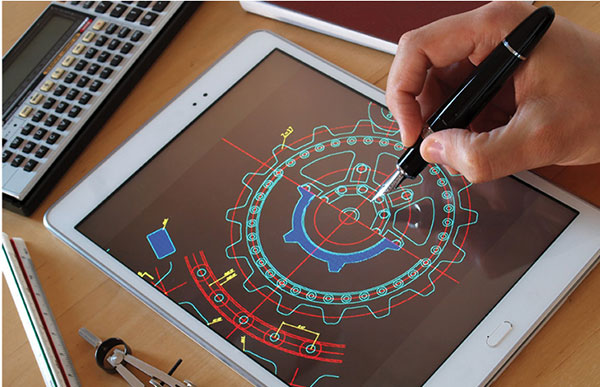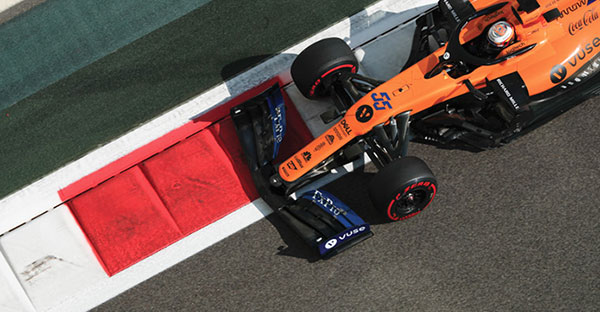Pushing the Design Envelope On the Go
With a new generation of visual designers, working anywhere in the world, CAD in the Cloud is emerging as a solution for mobile workers to build the future.

More companies are leveraging mobile and cloud-based CAD functionality. Image courtesy of Chetu.
Latest News
February 1, 2020
With 20 World Championships and 182 Grand Prix victories under his belt, Bruce McLaren built a behemoth of automotive design. His creative engineering design team continues to work with the very best tools, showcasing their engineering ingenuity.
With the magic of virtual design, engineers can easily remove a frame supports, reroute exhaust piping, move one component from one side of the car to the other—or change their whole idea and come up with a different configuration altogether. Using CAD solutions on different devices, users can change a nose shape for a formula race car, tweak the details of its cape, making it aerodynamically perfect, a masterpiece—with the least drag—that may race at unimaginable speed and come across the finish line, checkered flags waving.
At McLaren, designers in many different locations use the portability of Dell’s 15-in. workstations, loaded with Autodesk applications that allow them to design without archaic clay models like in the past. It is all part of the team’s “digital transformation,” that their principal digital architect says can simulate, model and integrate data to “bring their designs to life.”
But today’s high-caliber designers, like McLaren’s, need the cloud—to design anywhere, anytime on any premise. This may explain the strategic thinking behind the recent acquisition by PTC of Onshape—a pure software-as-a-service (SaaS) platform that links CAD with powerful data management and collaboration tools via the cloud.
Feeding A New Market Ecosystem
The utility of CAD, when offered via the cloud, is ratcheting up its functionality to be not only a business tool, but one that mobile engineers using tablets, compact workstations and other devices use for generative design (the use of a design program that generates finite outputs with given constraints). It allows on-the-spot design changes, without the need for complete CAD remodeling.
“In a large way CAD is evolving into a business management tool through SaaS,” says Jesse Coors-Blankenship, senior vice president of advanced development, PTC. “The more business functions that can access shared data and collaborate on shared data, the more effective a business can be. Not just in engineering and design but in procurement and sales, for instance. The more mobile CAD can be, the more effective a business network and market ecosystem can be.”
Blankenship highlights the business value that such a newfound network and market ecosystem can be.
“Generative design is a great example for how sharing data in a collaborative way in SaaS CAD can drive business value,” Blankenship says. “With generative design, design requirement changes result in immediate regeneration of designs without the need for timely CAD remodeling. In these ways, teams can utilize concurrent engineering to realize generative models that persist throughout product development cycles.”
Tom Schell is the national account manager for Chetu software in Atlanta. He considers CAD via SaaS to be a logical step for designers. It follows a line of disruption in the development of products that not only serve their designs, but also the presence of designers from anywhere, to anyone, whenever design tweaks are to be made. It brings efficiency and a whole new expectation of designers, by designers.

“People can now access and share designs through the provision of a simple link from anywhere with an internet connection,” Schell says. “More recently, some programs even facilitate multi-user simultaneous viewing and interacting with drawings, models and information. This ability to virtually immerse multiple people, such as design team members and other stakeholders from around the globe, creates the opportunity for collaboration that occurs on a near real-time basis.”
Ease-of-Access Generation
Mitch Hughes, CEO of ViZZ, a software company that enables physical design visualization for the architect-engineer community, says the chronology of CAD, going back decades began in the drawing board culture where engineers, detailers and artists worked pen to paper, alongside their cohorts, creating what he calls a “tactile” relationship.
About 30 years or so ago, the accuracy and speed of CAD became a new expectation and allowed file sharing. Today, many people have a hand in a design, and come from all layers of a project team. From the corner office to the engineer in the field, designers are still tactile—but not only with the proverbial crew that they’re used to working with. Now they’re working with non-CAD folks as well.
“CAD started as a computer program for the experts, but that too is changing,” Hughes explains. “As the most recent generations of people entering the design field bring with them the experiences of gaming, so too are the expectations of ease of use and multi-player experiences.
“This transition from the expensive, difficult-to-use, specialized programs built for the ‘professional,’ to the realization of value for all the stakeholders, whether a person is in the field, on the shop floor or in an office or home, is becoming a reality,” Hughes continues. “Part of this ease-of-access transition includes moving from the historical outlay of thousands of dollars, to a more financially attainable product that allows access and collaboration with non-CAD experts. Thus, the subscription-based SaaS model of product delivery further enables a broader audience to participate in the CAD revolution.”
Chetu’s Schell says the largest obstacle that mobile CAD platforms have to overcome is the industry’s ability to integrate new technological innovations.
“Many companies are fully committed to modernizing the workflow process, but many others are just now embracing new solutions. The more mainstream cloud computing, mobile application use and other modern tech solutions become in the industry, the more effective the software can be as a whole,” Schell says.
He adds that integration has been a challenge, but such a challenge can be overcome when the compatibility is customized and made to fit.
“Firms may be having difficulties with the latest CAD software initiatives due to some incompatibilities with their current software,” he says. “Custom software solutions have been proven to alleviate these issues and drastically improve workflow and productivity.”
Schell says that the development of CAD software’s move to mobile devices has sparked a considerable change in the engineering field, with more engineers and architects turning to the beautiful outcomes of engineering software applications like AutoCAD and putting it to work to streamline and modernize the design and engineering process.
“Cloud computing and mobile app development have allowed the entire design process to be conducted on the go, with users being able to create, edit and share their work instantly with other members of their team, which allows for greater collaboration and removes the whole process from a data silo.
“Also, it provides greater insights than traditional paper blueprints, ensuring that on-site construction managers and contractors know exactly what is needed, which can help maintain or even speed up the overall building time,” Schell continues.
Keeping Engineers and Designers On Track
Schell sees the proliferation of cloud computing and mobile devices as a change that continues to modernize the design community with firms tackling larger projects all over the world.
“We are seeing a greater demand for tech innovations that can keep their engineers and project managers on track in a global, connected business environment,” Schell says.

For McLaren Racing and McLaren Automotive, the race is on. Mark Roberts, head of design operations for McLaren Automotive, says they use virtual reality to pull in, as he calls it, “engineering hardpoints.” “Millimeters do matter,” he says. “You could literally bring in an engine, bring in a radiator position, bring in vision lines and [all necessary components].”
What used to be 30 hours of detailed modeling, now takes about 15 minutes, according to Roberts.
And things may get even easier if a cloud-based CAD solution is used. The promise of perfect design never looked so good.
More PTC Coverage
Subscribe to our FREE magazine, FREE email newsletters or both!
Latest News
About the Author
Jim Romeo is a freelance writer based in Chesapeake, VA. Send e-mail about this article to DE-Editors@digitaleng.news.
Follow DE






